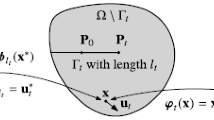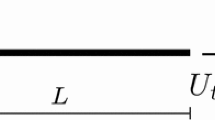Abstract
This paper is devoted to the use of gradient damage models in a dynamical context. After the setting of the general dynamical problem using a variational approach, one focuses on its application to the fragmentation of a brittle ring under expansion. Although the 1D problem admits a solution where the damage field remains uniform in space, numerical simulations show that the damage field localizes in space at a certain time and then a fragmentation of the ring rapidly occurs. To understand this phenomenon from a theoretical point of view, one develops a stability analysis of the homogeneous response by studying the growth of small perturbations. A dimensional analysis shows that the problem essentially depends on two dimensionless parameters \(\tilde{\ell }\) and \(\tilde{\dot{\varepsilon }}_0\), \(\tilde{\ell }\) being related to the characteristic length present in the damage model and \(\tilde{\dot{\varepsilon }}_0\) to the applied expansion rate. Then, since the product \(\tilde{\ell }\tilde{\dot{\varepsilon }}_0\) is small in practice, the problem of stability is solved in a closed form by using asymptotic expansions. The comparison with the numerical results allows us to conclude that the time at which the damage localizes and the number of fragments are really governed by the growth of the imperfections. To conclude, a numerical simulation of the fragmentation of a 2D ring is presented.








Similar content being viewed by others
References
Alessi R, Marigo J-J, Vidoli S (2014) Gradient damage models coupled with plasticity and nucleation of cohesive cracks. Arch Rat Mech Anal 214(2):575–615
Alessi R, Marigo J-J, Vidoli S (2015) Gradient damage models coupled with plasticity: variational formulation and main properties. Mech Mater 80(B):351–367
Ambati M, Gerasimov T, De Lorenzis L (2015) Phase-field modeling of ductile fracture. Comput Mech 55(5):1017–1040
Benallal A, Marigo J-J (2007) Bifurcation and stability issues in gradient theories with softening. Model Simul Mater Sci Eng 15(1):283–295
Borden MJ, Verhoosel CV, Scott MA, Hughes TJR, Landis CM (2012) A phase-field description of dynamic brittle fracture. Comput Methods Appl Mech Eng 217–220:77–95
Bourdin B, Francfort GA, Marigo J-J (2000) Numerical experiments in revisited brittle fracture. J Mech Phys Solids 48(4):797–826
Bourdin B, Francfort GA, Marigo J-J (2008) The variational approach to fracture. J Elast 91(1–3):5–148
Bourdin B, Larsen CJ, Richardson CL (2011) A time-discrete model for dynamic fracture based on crack regularization. Int J Fract 168(2):133–143
Bourdin B, Marigo J-J, Maurini C, Sicsic P (2014) Morphogenesis and propagation of complex cracks induced by thermal shocks. Phys Rev Lett 112(1):014301
Braides A (2002) \(\Gamma \)-Convergence for beginners volume 22 of Oxford lecture series in mathematics and its applications. Oxford University Press, Oxford
Comi C (2001) A non-local model with tension and compression damage mechanisms. Eur J Mech A Solid 20(1):1–22
Dal-Maso G, Toader R (2001) A model for the quasi-static growth of brittle fractures: existence and approximation results. Arch Rat Mech Anal 162(2):101–135
de Borst R, Brekelmans WAM, Peerlings RHJ, de Vree JHP (1996) Gradient enhanced damage for quasi-brittle materials. Int J Numer Methods Eng 39(19):3391
Drugan WJ (2001) Dynamic fragmentation of brittle materials: analytical mechanics-based models. J Mech Phys Solids 49:1181–1208
Francfort GA, Marigo J-J (1998) Revisiting brittle fracture as an energy minimization problem. J Mech Phys Solids 46(8):1319–1342
Glenn LA, Chudnovsky A (1986) Strain-energy effects on dynamic fragmentation. J Appl Phys 59:1379–1380
Grady DE (1982) Local inertial effects in dynamic fragmentation. J Appl Phys 53:322–325
Griffith AA (1921) The phenomena of rupture and flows in solids. Philos Trans R Soc Lond A221:163–197
Hakim V, Karma A (2009) Laws of crack motion and phase-field models of fracture. J Mech Phys Solids 57(2):342–368
Larsen CJ (2010) Models for dynamic fracture based on Griffith’s criterion. In Hackl K (ed) IUTAM symposium on variational concepts with applications to the mechanics of materials. Springer, Dordrecht, pp 131–140
Levy S, Molinari J-F (2010) Dynamic fragmentation of ceramics, signature of defects and scaling of fragment sizes. J Mech Phys Solids 58:12–26
Li T, Marigo J-J (2017) Crack tip equation of motion in dynamic gradient damage models. J Elast 127(1):25–57
Li T, Marigo J-J, Guilbaud D, Potapov S (2016) Gradient damage modeling of brittle fracture in an explicit dynamics context. Int J Numer Methods Eng 108(11):1381–1405
Lorentz E, Benallal A (2005) Gradient constitutive relations: numerical aspects and application to gradient damage. Int J Numer Methods Eng 194(50–52):5191–5220
Mardal K-A, Wells GN, Logg A (2012) Automated solution of differential equations by the finite element method—the FeniCS book. Springer, Berlin
Marigo J-J (1989) Constitutive relations in plasticity, damage and fracture mechanics based on a work property. Nucl Eng Des 114:249–272
Mercier S, Molinari A (2003) Predictions of bifurcation and instabilities during dynamic extension. Int J Solids Struct 40(8):1995–2016
Miehe C, Hofacker M, Schänzel L-M, Aldakheel F (2015) Phase field modeling of fracture in multi-physics problems. Part II. Coupled brittle-to-ductile failure criteria and crack propagation in thermo-elastic–plastic solids. Comput Methods Appl Mech Eng 294:486–522
Miller O, Freund LB, Needleman A (1999) Modeling and simulation of dynamic fragmentation in brittle materials. Int J Fract 96:101–125
Molinari J-F, Gazonas G, Raghupathy R, Rusinek A, Zhou F (2007) The cohesive element approach to dynamic fragmentation: the question of energy convergence. Int J Numer Methods Eng 69:484–503
Moré JJ, Toraldo G (1991) On the solution of large quadratic programming problems with bound constraints. SIAM J Optim 1:93–113
Pandolfi A, Krysl P, Ortiz M (1999) Finite element simulation of ring expansion and fragmentation: the capturing of length and time scales through cohesive models of fracture. Int J Fract 95:279–297
Pham K, Marigo J-J (2010a) The variational approach to damage: I. The foundations. Comptes Rendus Mécanique 338(4):191–198
Pham K, Marigo J-J (2010b) The variational approach to damage: II. The gradient damage models. Comptes Rendus Mécanique 338(4):199–206
Pham K, Marigo J-J (2011) From the onset of damage to rupture: construction of responses with damage localization for a general class of gradient damage models. Continuum Mech Thermodyn 25:147–171
Pham K, Amor H, Marigo J-J, Maurini C (2011a) Gradient damage models and their use to approximate brittle fracture. Int J Damage Mech 20(4, SI):618–652
Pham K, Marigo J-J, Maurini C (2011b) The issues of the uniqueness and the stability of the homogeneous response in uniaxial tests with gradient damage models. J Mech Phys Solids 59(6):1163–1190
Ravi-Chandar K (1998) Dynamic fracture of nominally brittle materials. Int J Fract 90(1):83–102
Ravi-Chandar K, Triantafyllidis N (2015) Dynamic stability of a bar under high loading rate: response to local perturbations. Int J Solids Struct 58:301–308
Rodríguez-Martinez JA, Vadíllo G, Fernández-Sáez J, Molinari A (2013) Identification of the critical wavelength responsible for the fragmentation of ductile rings expanding at very high strain rates. J Mech Phys Solids 61(6):1357–1376
Sicsic P, Marigo J-J, Maurini C (2014) Initiation of a periodic array of cracks in the thermal shock problem: a gradient damage modeling. J Mech Phys Solids 63:256–284
Simo JC, Hughes TJR (1998) Computational inelasticity. Interdisciplinary applied mathematics. Springer, Berlin
Vaz-Romero A, Rodríguez-Martinez JA, Mercier S, Molinari A (2017) Multiple necking pattern in nonlinear elastic bars subjected to dynamic stretching: the role of defects and inertia. Int J Solids Struct 125:232–243
Zhou FH, Wang YG (2009) Dynamic tensile fragmentations of Al(2)O(3) rings under radial expansion loading. In: DYMAT 2009: 9th international conference on the mechanical and physical behaviour of materials under dynamic loading, vol 1, pp 325–330
Zinszner J, Erzar B, Forquin P, Buzaud E (2015) Dynamic fragmentation of an alumina ceramic subjected to shockless spalling: an experimental and numerical study. J Mech Phys Solids 85:112–127
Author information
Authors and Affiliations
Corresponding author
Additional information
Publisher's Note
Springer Nature remains neutral with regard to jurisdictional claims in published maps and institutional affiliations.
Asymptotic analysis of the differential equation governing the amplitude of the perturbations
Asymptotic analysis of the differential equation governing the amplitude of the perturbations
Let us consider the second order linear differential equation
where \(\eta \) is a small parameter and the dot indicates the derivative with respect to t. In (70) f is a smooth function defined for \(t>0\) and such that
In the application we will take
and in such a case \(t_c=1/\sqrt{3}\), \(\dot{f}(t_c)=\sqrt{3}/6\). Denoting the general solution by \(y_\eta \), one wants to construct an asymptotic approximation of \(y_\eta \). For that one must discriminate three different cases according to t is smaller than, close to or greater than the zero of f, \(t_c\).
- 1.
When\(t>t_c\). Then, setting \(y(t)=\exp (z(t)/\eta )\), the differential equation (70) becomes
$$\begin{aligned} \eta \ddot{z}(t)+\dot{z}(t)^2-f(t)=0. \end{aligned}$$(72)The general solution \(z_\eta \) of (72) can be expanded in powers of \(\eta \):
$$\begin{aligned} z_\eta (t)=z_0(t)+\eta z_1(t)+\eta ^2 z_2(t)+\cdots . \end{aligned}$$Inserting that expansion into (72) gives for the first two terms:
$$\begin{aligned} \dot{z}_0(t)^2=f(t),\quad \ddot{z}_0(t)+2\dot{z}_0(t)\dot{z}_1(t)=0. \end{aligned}$$One easily deduces that \(z_0(t)=\pm F(t)\) where F is defined on \((0,+\infty )\) by
$$\begin{aligned} F(t)=\left| \int _{t_c}^t\sqrt{|f(s)|}ds\right| \end{aligned}$$(73)and \(z_1(t)=-\frac{1}{4}\ln f(t)+\text{ cst }\). Therefore the general solution \(y_\eta \) can be approximated (up to the “second order”) by
$$\begin{aligned} y_\eta (t)=\frac{a_1 \exp \Big (-\dfrac{F(t)}{\eta }\Big )+b_1 \exp \Big (\dfrac{F(t)}{\eta }\Big )}{f(t)^{1/4}} \end{aligned}$$(74)where \(a_1\) and \(b_1\) are two arbitrary constants. (Note that we could refine the approximation by calculating the next terms of the expansions. However, the present approximation up to second order will be sufficient for our purpose.)
- 2.
When\(0<t<t_c\). Then, setting \(y(t)=\exp (\mathsf iz(t)/\eta )\) where \(\mathsf i\) is the complex number equal to \(\sqrt{-1}\), one obtains by the same procedure that the general solution \(y_\eta \) can be approximated (up to the “second” order”) by
$$\begin{aligned} y_\eta (t)=\frac{a_0 \sin \Big (\dfrac{F(t)}{\eta }+\dfrac{\pi }{4}\Big )+b_0 \cos \Big (\dfrac{F(t)}{\eta }+\dfrac{\pi }{4}\Big )}{|f(t)|^{1/4}} \end{aligned}$$(75)where \(a_0\) and \(b_0\) are two arbitrary constants and F(t) is still given by (73). Note that the exponential functions of the previous case are here replaced by sinusoidal functions because of the change of sign of f at \(t=t_c\).
- 3.
In the neighborhood of\(t_c\). When t tends to \(t_c\) from below or from above, the approximations (75) and (74) diverge because \(f(t_c)=0\). One must construct another approximation when t is close to \(t_c\) and match it to the two previous ones. Note that, when t is close to \(t_c\), \(f(t)\approx \dot{f}(t_c)(t-t_c)\) and \(F(t)\sim \frac{2}{3}\sqrt{\dot{f}(t_c)}|t-t_c|^{3/2}\). So, in order that F(t) be of the order of \(\eta \), one makes the following rescaling of t:
$$\begin{aligned} t=t_c+\eta ^{2/3} T, \end{aligned}$$T being the rescaled time. Then, using the approximation \(f(t)\approx \dot{f}(t_c)(t-t_c)\), the differential equation (70) becomes
$$\begin{aligned} \frac{d^2 y}{d T^2}=\dot{f}(t_c)T y. \end{aligned}$$Its general solution involves the two Airy functions \(\mathsf {A_i}\) and \(\mathsf {B_i}\) defined by the following indefinite integrals:
$$\begin{aligned} \mathsf {A_i}(t)= & {} \frac{1}{\pi }\int _{0}^{+\infty }\cos \left( \frac{s^3}{3}+ts\right) ds,\\ \mathsf {B_i}(t)= & {} \frac{1}{\pi }\int _{0}^{+\infty }\left( \exp \left( -\frac{s^3}{3}+ts\right) \right. \\&\left. +\sin \left( \frac{s^3}{3}+ts\right) \right) ds. \end{aligned}$$Specifically, the general solution \(y_\eta \) of (70) can be approximated by
$$\begin{aligned} y_\eta (t_c+\eta ^{2/3} T)= & {} a_*\mathsf {A_i}\Big (\dot{f}(t_c)^{1/3}T\Big )\nonumber \\&+b_*\mathsf {B_i}\Big (\dot{f}(t_c)^{1/3}T\Big ), \end{aligned}$$(76)where \(a_*\) and \(b_*\) are two arbitrary constants.
In order that the three asymptotic approximations correspond to the same function \(y_\eta \) on the half real line, one must adjust the six constants. For that, one must write the matching conditions when \(|t-t_c|\) is small but |T| is large. On one hand, one uses the fact that
and, in the other hand, one uses the following behaviors of the Airy functions near \(\pm \infty \):
Comparing (74) and (75) with (76), one gets
Therefore, the general solution of (70) can be approximated by
the two constants \(a_1\) and \(b_1\) being fixed by initial conditions.
Rights and permissions
About this article
Cite this article
Geromel Fischer, A., Marigo, JJ. Gradient damage models applied to dynamic fragmentation of brittle materials. Int J Fract 220, 143–165 (2019). https://doi.org/10.1007/s10704-019-00356-y
Received:
Accepted:
Published:
Issue Date:
DOI: https://doi.org/10.1007/s10704-019-00356-y




